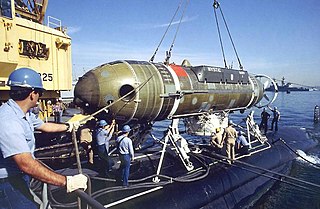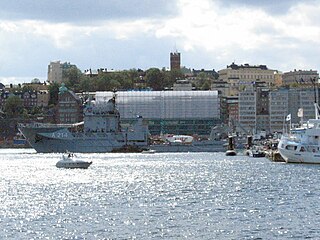| Look up submergence in Wiktionary, the free dictionary. |
Submergence may refer to:
- Submergence (film) , a 2017 film by Wim Wenders
- Submergence (novel), a 2012 book by J. M. Ledgard
- Submersion (disambiguation)
| Look up submergence in Wiktionary, the free dictionary. |
Submergence may refer to:
| This disambiguation page lists articles associated with the title Submergence. If an internal link led you here, you may wish to change the link to point directly to the intended article. |

Alvin (DSV-2) is a manned deep-ocean research submersible owned by the United States Navy and operated by the Woods Hole Oceanographic Institution (WHOI) in Woods Hole, Massachusetts. The vehicle was built by General Mills' Electronics Group in Minneapolis, Minnesota. Named to honor the prime mover and creative inspiration for the vehicle, Allyn Vine, Alvin was commissioned on 5 June 1964. The submersible is launched from the deep submergence support vessel RV Atlantis (AGOR-25), which is also owned by the U.S. Navy and operated by WHOI. The submersible has made more than 5,000 dives, carrying two scientists and a pilot, to observe the lifeforms that must cope with super-pressures and move about in total darkness, as well as exploring the wreck of Titanic. Research conducted by Alvin has been featured in nearly 2,000 scientific papers.

Mystic class is a class of Deep-Submergence Rescue Vehicles (DSRVs), designed for rescue operations on submerged, disabled submarines of the United States Navy or foreign navies. The two submarines of the class were never used for this purpose, and were replaced by the Submarine Rescue Diving Recompression System.

The Deep Submergence Insignia is a uniform breast pin worn by officers, both men and a few women of the United States Navy's submarine service who are qualified in submarines and have completed one year of regular assignment to a Manned or Unmanned Deep Submersible. The badge was first approved on 6 April 1981.

A deep-submergence vehicle (DSV) is a deep-diving manned submarine that is self-propelled. Several navies operate vehicles that can be accurately described as DSVs. DSVs are commonly divided into two types: research DSVs, which are used for exploration and surveying, and DSRVs, which can be used for rescuing the crew of a sunken navy submarine, clandestine (espionage) missions, or both. DSRVs are equipped with docking chambers to allow personnel ingress and egress via a manhole.

Trieste II(DSV-1) was the successor to Trieste—the United States Navy's first bathyscaphe purchased from its Swiss designers. The original Trieste design was heavily modified by the Naval Electronics Laboratory in San Diego, California and built at the Mare Island Naval Shipyard. Trieste II incorporated the original Terni, Italian-built sphere used in Trieste, after it was made redundant by the new high-pressure sphere cast by the German Krupp Steelworks. The Trieste sphere was suspended from an entirely new float, more seaworthy and streamlined than the original but operating on identical principles. Completed in early 1964, Trieste II was placed on board USNS Francis X. McGraw (T-AK241) and shipped, via the Panama Canal, to Boston.
The Priz class is a type of Deep Submergence Rescue Vehicle (DSRV) operated by the government of Russia. There are known to be at least five vessels of the class, several of which were involved in the failed rescue attempt when the Kursk sank on 12 August 2000. The Russian word "Priz" (“приз”) means "prize".

AS-28 is a Priz-class deep-submergence rescue vehicle of the Russian Navy, which entered service in 1986. It was designed for submarine rescue operations by the Lazurit Design Bureau in Nizhny Novgorod. It is 13.5 m (44 ft) long, 5.7 m (19 ft) high, and can operate up to a depth of 1,000 m (3,300 ft).

The LR5 is a manned submersible which was used by the British Royal Navy until 2009 when it was leased to support the Royal Australian Navy. It is designed for retrieving sailors from stranded submarines and is capable of rescuing 16 at a time. The Royal Navy now has the use of the NATO Submarine Rescue System.
AS-34 is a Russian Priz-class deep-submergence rescue vehicle, or rescue mini-submarine, which went into service in 1989.

A deep-submergence rescue vehicle (DSRV) is a type of deep-submergence vehicle used for rescue of downed submarines and clandestine missions. While DSRV is the term most often used by the United States Navy, other nations have different designations for their vehicles.

DSRV-2Avalon was a Mystic-class deep-submergence rescue vehicle rated to dive up to 5000 feet to rescue submarine crews trapped deep under the sea. The submarine was acquired in response to the loss of the USS Thresher, so that the Navy would have a way to rescue trapped submarine crews.

Turtle (DSV-3) is a 16-ton, manned deep-ocean research submersible owned by the United States Navy. It is sister to Alvin (DSV-2), and also an Alvin class deep-submergence vehicle.
DSV-4 is a 25-ton, manned deep-ocean research submersible owned by the United States Navy, now known only by its hull number, not by its former name.

DSRV-1Mystic is a deep-submergence rescue vehicle that is rated to dive up to 5,000 feet. She was built by Lockheed for the US Navy at a construction cost of $41 million and launched 24 January 1970. She was declared fully operational in 1977 and named Mystic.
Archimede is the French and Italian form of Archimedes. It may also refer to:

URF is the Royal Swedish Navy’s Submarine Rescue Vessel.
The Rainbowfish class bathyscaphe is a Chinese deep submergence vehicle under development in 2015 and originally scheduled to enter service in 2019. The Rainbowfish is a second generation bathyscaphe designed to be able to dive to a depth of 11 km, effectively covering 100% of the oceanic floor. The general designer is Mr. Cui Weicheng (崔维成), who was the first deputy general designer of the first generation bathyscaphes Sea Pole and Jiaolong. Unlike other Chinese deep submergence vehicles developed earlier, the Rainbowfish was developed under a new business model, raising capital from private enterprise.

Anteo is a submarine rescue ship of the Italian Navy, assigned to Raggruppamento Subacquei ed Incursori "Teseo Tesei" (COMSUBIN). ITS Anteo is the third ship to bear this name in the Italian Navy. The ship's design was developed by the "Ufficio Navi Speciali del Reparto Progetti Navi", according to the guidelines provided by the Navy General Staff. The ship was built at Cantiere Navale Breda di Porto Marghera and commissioned to the Italian Navy on 31 July 1980.

SRV-300 is a deep-submergence rescue vehicle that is rated to dive up to 300 m (980 ft). It was built by DRASS Galeazzi (Livorno) for the Marina Militare, and is capable of descending to 300 metres (980 ft) carrying 12 passengers in addition to crew. SRV-300 is hosted by Anteo, berthed at La Spezia.
The Lazurit Central Design Bureau is a company based in Nizhny Novgorod, Russia. It is part of the United Shipbuilding Corporation.